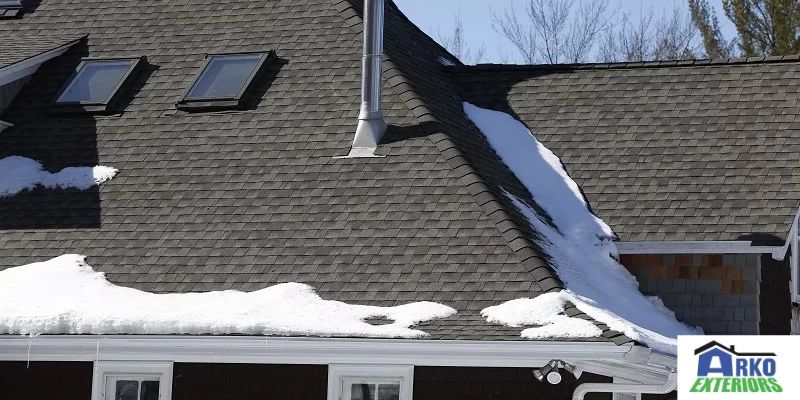Having problems with your roofing system is a normal experience, but they can be especially concerning in winter.
Is It Possible To Install A New Roof During Winter?
A good roof over your house is essential to your and your family’s safety. And if there is a need to install a new roof during the winter, it can and should be done. Although winter is not the ideal time for a roof installation, having a sturdy roof that functions properly during winter is essential. Therefore, installing a new roof is possible during winter.
Factors To Consider When Installing A New Roof In Winter

Weather conditions during winter can be unsafe for the crew working on your roof. You should put measures in place to ensure the safe installation of a new roof during this period.
Here are some things to keep in mind when a crew is installing a roof in the winter:
1. Hypothermia
Hypothermia happens when the core body temperature of a person is below the level that is needed to ensure the proper functioning of critical organs. Moisture and low temperatures are the two causes that lead to conditions of hypothermia.
When working on a roof during winter, the cold in combination with human perspiration will conduct heat away from the body of a worker. As a result, the individual may develop hypothermia. Some of its signs may include clumsiness, shallow breathing and sudden drowsiness.
Immediately call for emergency help in case someone on the work crew develops hypothermia. Remove wet clothes from the person’s body and get them to a heated area as soon as possible. You can also cover the person with a dry blanket.
2. Falls
There should be a safety plan for every job. The crew installing a new roof in the winter should be protected with temporary rooftop guardrails to protect them from falling. However, you should know that falls are common in this type of work condition.
To prevent falls, check to ensure that your ladder can work well on ice. Slipping off the ladder in icy conditions even before the work starts is quite common. You should make sure that a worker makes use of the ladder appropriately to avoid accidents.
2. De-icing and snow removal

Hire a well-trained team to remove ice and fresh snow from your roof before allowing roofing contractors to access it. Having the same people that will install the new roof do the job of snow and ice removal is not ideal. This is because they may only focus on getting the job done and not on their safety.
There are different methods that can be used in removing snow and ice from your roof. Ensure that the method the crew uses will not damage the structure or other components of your house. Moreover, you should ensure that all snow is removed to avoid slipping.
Another danger of roofing in the winter season is the ability of snow to conceal certain areas of the roof. For instance, a light snowdrift can hide roof openings which can cause a worker to fall, injuring themselves and damaging the roof.
3. Frostbite
Frostbite can happen to you when your skin is not well-protected from strong winds and the freezing temperatures of the winter season. The ears, toes, fingers, and nose are the body parts that are most susceptible to frostbite. Frostbite is noticeable, and you will probably know if you have it. The affected body part will turn yellow, white, and eventually black or blue. You should immediately raise the temperature of the susceptible body parts in tepid (not hot) water if you or anybody in the work crew gets frostbite. You should also call for emergency help as soon as possible.
4. Winter driving
Hazardous conditions can develop during the winter. A roofer may need to transport roofing materials and may fall victim to icy, snowy roads or driving conditions that make it difficult to see. The roofing crew should be provided with a defensive driving course for the season. Drivers get an insurance break once the course is completed, and you will feel relieved knowing that the crew knows how to drive in such conditions.
Moreover, you will be confident that there will be no accident that will distract them from getting the job done properly. Please note, you should not allow workers to install a new roof in temperatures below 40 degrees if possible. This will help prevent potential injury, wasted labor, and material failure.
5. Dehydration
Safety is crucial to avoiding injury when working on rooftops. This becomes even more crucial when work is to be done on the roof in the winter. Roofers should have a rehydration plan as the season can be grueling. The plan should be to stay hydrated at all times. This may include stretching before work, drinking enough water, and eating healthy during work breaks, to name a few. These safety tips seem simple, but they will ensure that the body is in top condition through the roof installation process.
Conclusion
Installing a new roof during the winter season is possible. However, measures to prevent the risk of injury must be put into place to ensure the successful completion of the job. Moreover, hiring the right crew with the required experience will ensure that installing a new roof in winter is successful. If you are in Minnesota, consult the expert roofing technicians at Arko Exteriors. Their licensed and expert professionals will be able to help you carry out roof improvements in all kinds of weather conditions.

